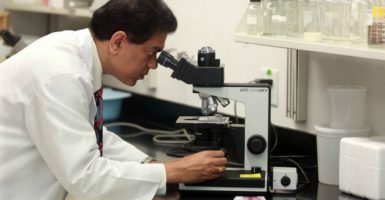The National Institutes of Health has announced its support for expanded research into the development of chimeras, experimental genetic combinations of human beings and animals that, some experts say, may yield immense benefits in medical treatment and scientific knowledge.
To understand the significance of NIH’s proposed expansion, it is important to understand what chimerism is—and is not. The Greek word chimera refers to a mythical creature that was part goat, part snake, and part lion. In modern science, the term refers to any organism or tissue that contains at least two genetically distinct kinds of DNA. Chimeras can be plants or animals.
The stated aim now, offered in new regulations published on Aug. 4, is to fund research putting human cells into very early animal embryos, even nonhuman primates in some cases.
Given this basic definition, some forms of chimerism occur naturally, as when two zygotes fuse or when two individuals exchange cells during embryonic development, as can happen with twins developing in the womb, for example.
The chimeras of interest to the NIH, however, are deliberate experimental efforts.
The practice does not refer to therapies like a mitral valve replacement using a pig’s heart valve or other mammalian tissue because this procedure does not involve the admixture of DNA or the potential for the creation of a genetically new or altered animal-human combination.
For decades, scientists have engaged in noncontroversial practices involving intermixing animal and human cells such as growing human cancer tumors in mice to study disease processes and evaluate treatment strategies.
But NIH has for years prohibited chimeric experiments involving pluripotent stem cells, which are capable of developing into any organ or tissue in the body. The prohibition, contained in guidelines dating to 2009, bars “introducing human pluripotent cells into nonhuman primate blastocysts and the breeding of animals into which human pluripotent cells may have contributed to the germ line (egg or sperm cells).”
Last September, NIH imposed a moratorium on funding for any experiments involving the introduction of such cells (human to animal) before the stage of gastrulation, the formation of the three germ layers in the early embryo.
But one year has not been too short a time for NIH to hold a workshop to ponder lifting this moratorium.
The stated aim now, offered in new regulations published on Aug. 4, is to fund research putting human cells into very early animal embryos, even nonhuman primates in some cases. This, NIH says, would allow new disease modeling, drug testing, and eventually the growth in animals of human organs that could be used for transplantation.
The problematic aspect is that when added so early in development, the human cells could end up, well, anywhere in the developing animal. In the worst case, the human cells could end up in gonadal tissue and form human gametes (eggs or sperm) within the animal’s body.
The breeding of new forms of life—human-animal hybrids—could then be in view, or even the development of an animal with a largely human or fully human brain. NIH’s answer to objections like these seems to be to preclude such animals from breeding (this would likely not be 100 percent effective—just ask anyone who has run an animal facility).
NIH is also forming a special screening panel to review chimera grant applications, based on recent recommendations from the International Society for Stem Cell Research (this group sees virtually no ethical problems with embryo research and destruction, including cloning, so it is not surprising that it has little problem with chimeras).
The brave new world beckons. As a fact sheet produced by Kansas Right to Life notes, opening of this pathway to expanded chimera creation would inevitably mean the destruction of many embryonic humans as techniques are tested and refined. No matter what we might learn from watching cells grow in the unique situation chimeras represent, researchers will be killing nascent human embryos to harvest their cells.
If human-animal chimeras are allowed to be intentionally created for research, the door is also open to reproductive experiments, creating part-human organisms or designer animals to, say, carry out dangerous or degrading tasks human beings do not want to perform. Or donate organs these creations sacrifice for their human betters.
Until today, we might have hoped that NIH would let sleeping dog-men lie and maintain its funding moratorium. In one of H.G. Wells’ dystopian novels, a man is rescued at sea and brought to an island where he encounters a mad scientist, played by Marlon Brando in a movie adapation, who has spent 17 years creating “animals fused with human genes.” “The Island of Dr. Moreau” ends tragically with death abounding.
The new NIH proposal unveiled Thursday, in turn, begins with death abounding amidst the hubris that scientists can foresee, and forestall, every harm their manipulations of the human-animal boundary will cause.
To play God is to put power before knowledge. For this reason alone, the NIH funding moratorium on this type of research should continue while ethical alternatives are explored and fully funded.
This article has been updated to clarify Marlon Brando played the part of a mad scientist in the movie adaption of H.G. Wells’ novel.































